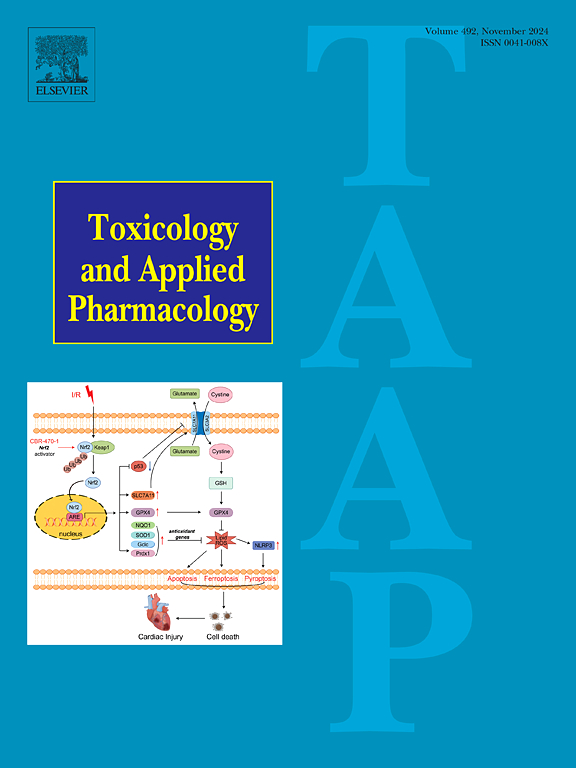Gallium maltolate and cisplatin co-treatment effectively targets triple-negative breast cancer in spheroid and mouse models
IF 3.3
3区 医学
Q2 PHARMACOLOGY & PHARMACY
引用次数: 0
Abstract
Triple-negative breast cancer (TNBC) is a subtype of breast cancer that lacks targeted therapies and is characterized by high invasiveness and metastatic potential. Our previous work demonstrated that GaM (gallium maltolate) blocks cell cycle progression and impairs ribosomal synthesis in TNBC cells. Moreover, GaM treatment promotes ferroptosis activation, and its combination with cisplatin exhibits synergistic effects. To further evaluate the efficacy of these treatments, we applied them to three-dimensional spheroid and mouse models. Two types of spheroids were generated: one composed solely of TNBC cells (MDA-MB-231) and the other a co-culture with normal breast cells (MCF10A). In both MDA/MCF10A and MDA-MB-231 spheroids, we observed enhanced p53 activation and increased p21 expression, with the effects being more pronounced in the MDA-MB-231 spheroids. These effects were stronger with the combination treatment than with either treatment alone. Similar results were observed in a xenograft model, where tumors formed from MDA-MB-231 cells in nude mice. The combination therapy reduced tumor size to a similar extent as cisplatin alone and did not cause adverse effects in mice. The combination therapy induced apoptosis, nucleolar stress, and ferroptosis. Additionally, the treatment inhibited cell migration and metastasis - by increasing E-cadherin levels and reducing metalloproteases. These findings provide a strong foundation for further mechanistic studies and potential clinical applications.
在球体和小鼠模型中,麦芽酸镓和顺铂联合治疗可有效靶向三阴性乳腺癌
三阴性乳腺癌(TNBC)是一种缺乏靶向治疗的乳腺癌亚型,具有高侵袭性和转移潜力。我们之前的工作表明,GaM(麦芽酸镓)阻断细胞周期进程并损害TNBC细胞的核糖体合成。此外,GaM治疗促进了铁下垂的激活,并与顺铂联合使用具有协同作用。为了进一步评估这些治疗的疗效,我们将它们应用于三维球体和小鼠模型。产生了两种类型的球体:一种仅由TNBC细胞(MDA-MB-231)组成,另一种与正常乳腺细胞(MCF10A)共培养。在MDA/MCF10A和MDA- mb -231球状体中,我们观察到p53激活增强,p21表达增加,其中MDA- mb -231球状体的作用更为明显。这些效果与联合治疗比单独治疗更强。在裸鼠体内MDA-MB-231细胞形成肿瘤的异种移植模型中也观察到类似的结果。联合治疗减少肿瘤大小的程度与单用顺铂相似,并且在小鼠中没有引起不良反应。联合治疗可诱导细胞凋亡、核仁应激和铁下垂。此外,治疗通过增加e -钙粘蛋白水平和降低金属蛋白酶抑制细胞迁移和转移。这些发现为进一步的机制研究和潜在的临床应用提供了坚实的基础。
本文章由计算机程序翻译,如有差异,请以英文原文为准。
求助全文
约1分钟内获得全文
求助全文
来源期刊
CiteScore
6.80
自引率
2.60%
发文量
309
审稿时长
32 days
期刊介绍:
Toxicology and Applied Pharmacology publishes original scientific research of relevance to animals or humans pertaining to the action of chemicals, drugs, or chemically-defined natural products.
Regular articles address mechanistic approaches to physiological, pharmacologic, biochemical, cellular, or molecular understanding of toxicologic/pathologic lesions and to methods used to describe these responses. Safety Science articles address outstanding state-of-the-art preclinical and human translational characterization of drug and chemical safety employing cutting-edge science. Highly significant Regulatory Safety Science articles will also be considered in this category. Papers concerned with alternatives to the use of experimental animals are encouraged.
Short articles report on high impact studies of broad interest to readers of TAAP that would benefit from rapid publication. These articles should contain no more than a combined total of four figures and tables. Authors should include in their cover letter the justification for consideration of their manuscript as a short article.

 求助内容:
求助内容: 应助结果提醒方式:
应助结果提醒方式:


